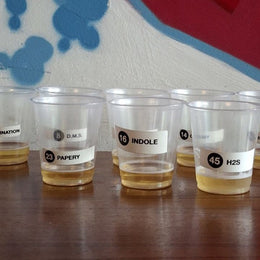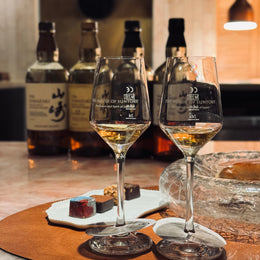
There was a time in my life that if I heard someone say "Oleo Saccharum" out loud, I'd expect the furniture to start floating. It certainly sounds enough like some sort of incantation, after all.
But the strange sounding substance is neither a spell, nor a chemical out of a lab. Rather, it's ... a syrup.
Well, yes and no. Oleo Saccharum, or Oleo, is a little bit of a quirky cousin to what we understand makes up a syrup. You see, while a normal syrup usually entails dissolving sugar into water, oleo saccharum employs the use of an added factor of oils to create a entirely unique citrusy scent that's key to bringing the zing to some of your favourite cocktails!
Think of Oleo Saccharum as someone expressing a peel in your face with your mouth open, rather than taking a hulking bite into an orange!

The secret is in its name: "Oil Sugar"

Image Source: Food 52
"Oleo Saccharum" is Latin for "Oil Sugar". And that's quite literally what it is! The substance can be understood as a very rich, fragrant and citrusy syrup, made simply by mixing sugar with citrus peels. That's it! No addition of water needed!
How does it work? Because sugar is hygroscopic (meaning it absorbs moisture), it works beautifully to draw out the fragrant oils present in citrus peels. With no additional water added, these essential oils are extracted into the sugar, which makes for a nice, thick syrup brimming with zesty goodness.
Tracing Back the History of Oleo
Well, where did it come from? Well, Oleo is oddly enough one of the few cocktail-related tinctures that have a history that's a little bit muddier than what we've come to expect. Recorded mentions of Oleo have been mentioned as early as in the 1670s, but not explicitly so. Rather, recipe books more of described what would come to be known as Oleo.
A widely mentioned "first instance" of "Oleo" would be in Hannah Woolley's 1670 recipe for Limonado. The recipe instructs to 'brew together' lemon peels (Misspelt as 'pill') with sugar and other punch ingredients.

A description of what is essentially Oleo in Oxford Night Caps, 1827.
Other mentions included Richard Cook's 1827 work, 'Oxford Night Caps,' which provided instructions on how to "extract the juice from the rind of three lemons by rubbing them with loaf sugar". The widely-acclaimed "forefather of mixology" Jerry Thomas even popularised the technique in his seminal 1862 edition of "How to Mix Drinks". The work would include instructions to "rub the sugar over the lemons until it has absorbed all the yellow part of the skins".
The popularity of Oleo decreased somewhat in the 20th century but fortunately, the appeals of the substance has seen it witness a resurgence in recent years.
Right, that's all good and all, but what appeal? Well, on the surface it has more than a few benefits. It's versatile and can be used in almost any drink, alcoholic or not. In a cocktail? Sure thing. Pop it into some soda water for flavor? That works too! Of course, there's also the eco-friendly part of things, where it minimises food waste and ensuring you truly use every part of the citrus fruit.

Cross section of a lemon. (Image Source: Tomonori Kawano)
Citrus Peels Not Citrus Juice: What Gives Oleo It's Unique Flavour
There's also the aspect of flavor. And for that, one must understand how a citrus fruit works.
The part we commonly refer to as the peel of citrus fruit consists of two distinct layers: the epicarp and the mesocarp. The epicarp (outermost layer), is characterised by a crisp, zesty flavor due to the tiny oil glands within. In contrast, the mesocarp (spongy layer beneath), is typically bitter.
What might typically be used in a cocktail would be citrus juice. Thing is, juice from the flesh of a citrus fruit contains limonene, a chemical composition that results in that familiar tangy, fresh flavor that we've come to expect when we hear "citrus".

Ctirusy, versatile nectar of the citrus peel, mmmmm. (Image Source: Arishtam)
So what this oil-centric concoction does, is present a syrup that exhibits more floral and herbal characteristics that are less headstrong. Think of it as someone expressing a peel in your face with your mouth open, rather than taking a hulking bite into an orange!
Of course, Oleo is relatively easy to make at home. Here's how you do it!
Ingredients:
- Citrus peels
- 25g of sugar per citrus peel.
Steps:
-
Wash and peel your citrus fruits. You can choose any sort of variety, although do note that each variety will taste slightly different. Think limes versus lemons, for example.
- You can choose to zest the peels for quicker infusion, although if you ask me, peeling the fruit is less effort and achieves the same result (Provided you have more time, of course).
- Put your peels/zest into a glass jar with the sugar. Try your best to layer the peels and sugar, or make sure your zest is fairly well mixed inside. This is to encourage the "infusion".
- Let it rest for 24-48 hours. Stir and squeeze the mix from time to time. The longer you let the mixture sit, the more oils will be expressed.
- Pour the mixture through a strainer. Naturally, use a finer strainer if your citrus is zested.
- Put the Oleo in a clean bottle and refrigerate.
- Keep it in the fridge and it should last for at least one month. Give it the ol' taste and sniff test before every use!
So all you citrus lovers out there, let's get cracking!

*Suspiciously racoon-like noises*
Contributed by @Definitelynotthreeracoons







